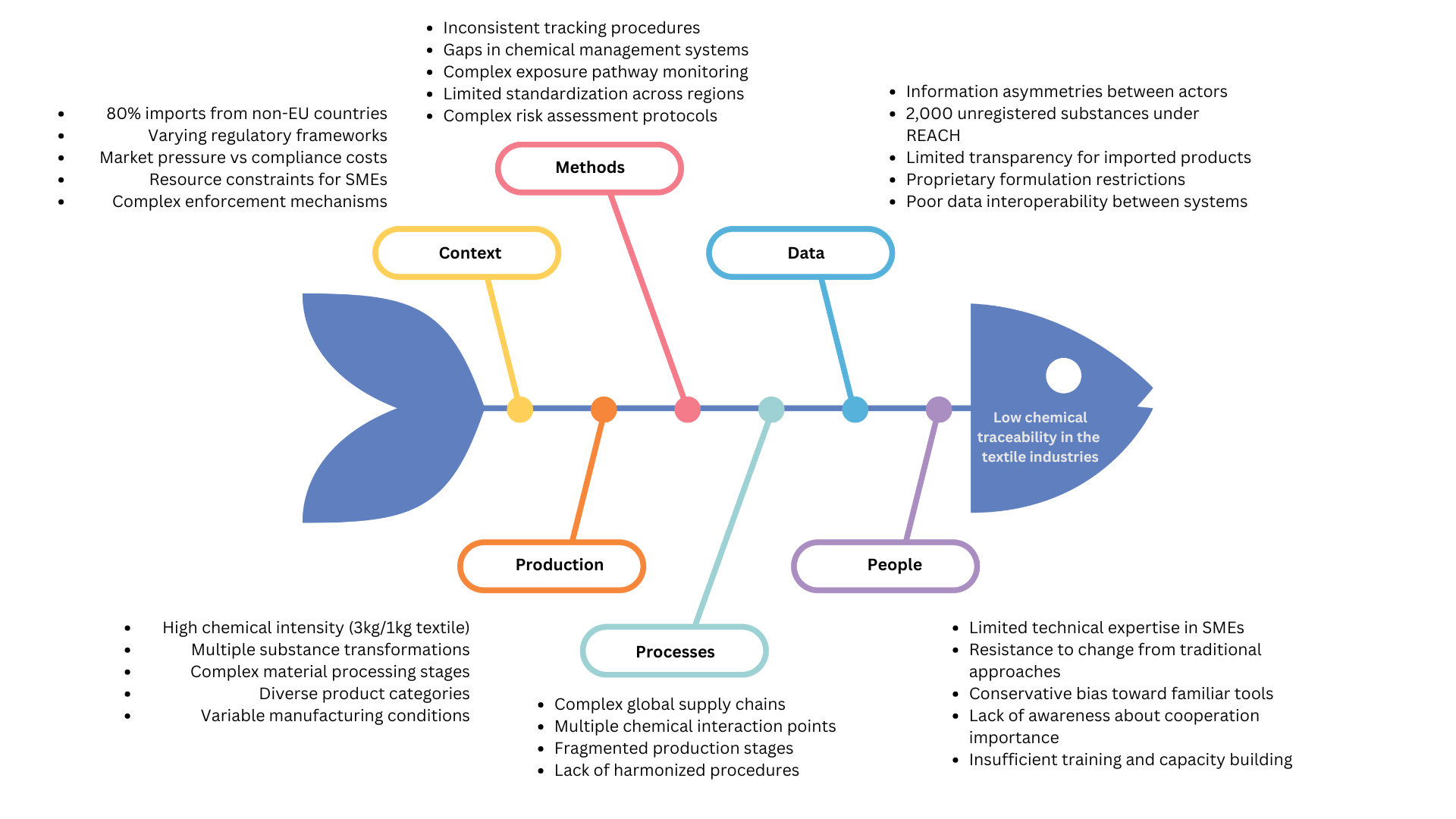Status Quo Analysis - Textile Sector
This status quo analysis reports the current state of chemical traceability in the textile and carpet industries, revealing a complex interplay between stakeholders, regulatory frameworks, and market dynamics. Current gaps in REACH registrations and information requirements highlight the need for more comprehensive solutions. What is more, the evident disparities between large corporations and SMEs emerge as a significant challenge. The analysis culminates in the identification of five fundamental dimensions for successful implementation of chemical traceability: 1. systemic approach, 2. training and capacity building, 3. technology adoption, 4. policy frameworks, 5. market dynamics.
2. Understanding Chemical Traceability in the Textile Industry
2.6. Unveiling the Weak Links
The complex landscape of chemical traceability in the textile industry reveals significant gaps and challenges that require systematic attention, as demonstrated by this overarching analysis using the SWOT and Ishikawa tools. The assessment shows an imbalanced situation where weaknesses and threats currently outweigh strengths, particularly evident in the information asymmetries, registration gaps, and limited transparency of imported products that make up 80% of EU textile consumption.
However, the analysis also reveals substantial opportunities for transformation through growing market demands, emerging technologies, and potential for harmonised systems. The combination of EU support programs, increasing technological capabilities, and push for circular economy initiatives provides a strong foundation for addressing current challenges. This suggests that while the industry faces significant hurdles in chemical traceability implementation, there exists a clear pathway for development through coordinated action, technological adoption, and systematic capacity building, particularly focused on supporting SMEs and creating harmonised global standards.

The Ishikawa analysis reveals six key dimensions contributing to low chemical traceability in the textile industry, highlighting both technical and systemic challenges. The analysis demonstrates how interrelated factors across people, methods, data, processes, context, and production create a complex web of obstacles. Notably, the data and process dimensions emerge as particularly critical, with information asymmetries and complex global supply chains creating fundamental barriers to effective traceability implementation.
Examining the relationships between these dimensions uncovers how limitations in one area amplify challenges in others. For instance, the people dimension's limited technical expertise compounds the difficulties posed by complex methods and data requirements, while production complexity intensifies the challenges of process standardisation. The context dimension, particularly the high proportion of imports from non-EU countries (80%), exacerbates these challenges across all other dimensions. This interconnected nature of the barriers suggests that successful interventions must address multiple dimensions simultaneously rather than focusing on isolated solutions.

In sum, the textile industry's chemical traceability challenges require a comprehensive approach combining harmonised regulation, enhanced value chain communication, and continued research into chemical hazards, exposure pathways and safe alternatives. Future efforts must focus on developing more robust tracking systems, expanding chemical registration requirements, and improving information flow throughout the global supply and value chain.
As mentioned previously, Internet of Things (IoT) and emerging sensor technologies and digital solutions for data gathering offer promising avenues for improving traceability. However, their successful implementation will require coordinated action across the industry, including standardisation and harmonization of approaches and increased support for SMEs. Policy development should focus on closing regulatory gaps, particularly for imported articles, while fostering innovation in safer chemical alternatives and traceability solutions.
The integration of chemical management best practices from frameworks like the (Camera Nazionale della Moda Italiana, 2021), combined with specific measures to address challenges posed by substances of concern and high concern, will be crucial for moving the industry toward safer chemical use and enhanced environmental stewardship. Achievement in this transformation will require sustained commitment from all stakeholders in the textile value chain.
